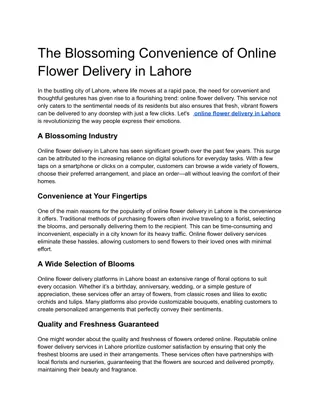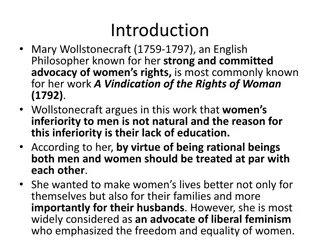Understanding Secondary Economic Activities in Lahore College for Women University
Economic activities are classified into five types, with secondary activities involving the processing of raw materials into industrial products. This sector, including manufacturing and industry, plays a crucial role worldwide. Examples of secondary activities range from metalworking to textile production, showcasing the diverse nature of this sector.
Download Presentation

Please find below an Image/Link to download the presentation.
The content on the website is provided AS IS for your information and personal use only. It may not be sold, licensed, or shared on other websites without obtaining consent from the author. Download presentation by click this link. If you encounter any issues during the download, it is possible that the publisher has removed the file from their server.
E N D
Presentation Transcript
Topic: Introduction to economic activities Secondary Activities of man Lahore College for Women University, Lahore
Human activities all over the world have been categorized into 5 types each of them occurring at different ratios in different countries all over the world. There are five types of economic activities, primary, secondary, tertiary, quaternary and quinary. The excess of primary activities is a characteristic of under developed countries. The world s richest countries have the largest ratio of people engaged in tertiary and quaternary sectors, the mediocre one s having the largest ratio of tertiary and secondary economic activities. Quinary quaternary Tertiary Secondary Primary
Manufacturing based activities Economic activity involving the processing of raw materials and their transformation into finished industrial products are called Secondary economic activities .the manufacturing sector composes the secondary activities. people engaged in converting raw materials into product form are called red collar workers
Map Showing the people involved in Secondary activities over the world
Manufacturing and Industrial sector Manufacturing is a process of refining the raw materials in product form , where as industry is a place where the manufacturing takes place. The secondary sector is composed of manufacturing and industrial activities of mankind and is some times known as the production sector. This sector of human economy include all those activities of humans that transform raw materials into products and goods. This sector includes:- 1.Processing of raw materials 2. Food manufacturing 3. Textile manufacturing and industry
Examples The secondary sector of the economy manufactures finished goods. All of manufacturing, processing, and construction lies within the secondary sector. Activities associated with the secondary sector include : A few activities associated with the secondary sector include : Metal working and smelting Automobile production Textile production Chemical and engineering industries Aerospace manufacturing Energy utilities, engineering Construction and shipbuilding. Paper making Production of Juices Industries linked with making food products
Two major divisions of secondary sector Heavy Industry It refers to production of products which are either heavy in weight or in the processes leading to their production. It is a term meaning construction for big projects. Heavy industry projects can be generalized as more capital intensive or as requiring greater or more advanced resources, facilities or management. Capital intensive Harmful for the environment Are made in the outskirts of the country Examples: cranes, bulldozers , aero planes, Cars, coco cola Industry etc.
2. Light Industry These industries are on a small scale. Light industries are those which do not require too much money for production. Such industries are more consumer orientated. They do not require too many machines thus being less costly. These industries are not harmful to the environment as they require little or no machinery, ultimately leading to no release of fume or harmful gasses. Such industries can be made near residential areas and require no need to be made on the out skirts of towns or cities. The picture shows a tapestry factory which does not require heavy machinery.
Types of Manufacturing 1. Household type: Human civilizations started from this type of manufacturing This type of industry depends on manual power rather than technology. It composes of industries made on small scales ( in houses). Products made by such industries are often consumed my the members of the house and do not find their way to the local markets.
2. Community type The manufacturing takes place for the local community. This industry manufactures goods on a local scale. It drives raw material from far off places and serves the local community. It does not employ many workers. Bakers or the owners of bakeries get refined wheat and flour etc and then use these to make products for the local community. This type of industry that serves its community is called the community type. 3. Simple Type This type of industry refines products for the use of other industries. Reducing the raw materials by refining them for further use. Such industries are located where there are numerous raw material reserves such as those of coal, salt and other such minerals. They are interlinked with the primary activity of mining. The materials extracted my mining are refined by these industries.
4. Complex type This type of Industry was formed as a result of Industrial revolution. A large number of workforce is required by such industries. These use a large amount of raw material but varieties are consumed only once. It requires complicated machinery. The products produced by such industries are not only sold locally but also go to far off places. Example: The coca cola industry or the Sweden Oriflame industry that exports its goods to Pakistan. Coca cola industry Oriflame industry Sweden
Tertiary Sector Service based activities This sector of economy is also known as the service sector or service industry. The basic characteristic of this sector is the production of services instead of end products. Activities associated with this sector include retail and wholesale sales, transportation and distribution, entertainment (movies, television, radio, music, theater, etc.), restaurants, clerical services, media, tourism, insurance, banking, healthcare, and law. People engaged in the service sector and provide services are called the grey collar workers Women engaged in the tertiary sector of economy make up the category of pink collar workers
These include education, the health service, transport, financial services, banking, repair services and retail shops. 1. Teaching profession 2. Doctor 3. Police officer 4. Genitor Basically it includes all those activities of man related to the provision of services
Characteristics The number of people engaged in the tertiary sector are more in MDC S and less in Under developed countries. The tertiary sector consists of the left over part of economic activities after the final products have been provided to the consumers. In this sector the focus is on interacting with people and serving the consumer rather than transforming physical goods The more well developed a country the more people engaged in this sector
. Quaternary Sector ( Knowledge based activities) This sector is knowledge orientated. The quaternary sector of the economy is a way to describe a knowledge-based part of the economy which typically includes knowledge- based services. It also includes middle management developed countries and requires a highly educated workforce. People engaged in Quaternary sector or in the middle management are called white collar workers
Similarity and contrast between Tertiary and Quaternary sectors Some times the quaternary and tertiary sectors are considered as one because they both deal with the providing services. The main difference between the tertiary and the quaternary sector is that the tertiary sector deals with all sort of services on a lower scale and not high ranks. Such as a teacher, a doctor etc. but the quaternary sector deals with information technology. Research and development. Especially with education based activities. The quaternary activities refer to intellectual occupations which are advance and specialized such as thinking, research and developing new ideas. . Example highly qualified individuals visit universities to give seminars. It includes services such as information generation and sharing, information technology, consultation, education, research and development, financial planning, and other knowledge-based services. This sector produces the highest incomes. An people engaged in such activities are quite mobile as for the development of their careers.
Quinary Sector (Intellectually based macro level activities) Quinary sector of economy composes of the highest levels of decision making in a society or economy. Quinary activities are the ones involving complex decision making and advancement of human capacities. officials in fields such as government, science, universities, health care and culture. People engaged in quinary activities are called the Golden collar























